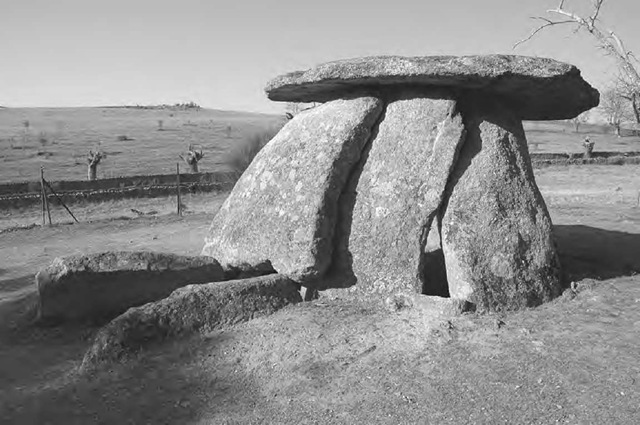Antas are a distinctive type of dolmen concentrated in the Alentejo region of central Portugal and the bordering provinces of western Spain. Anta in Portuguese simply means “dolmen,” but the word has been appropriated to signify a particular method of construction. A large, flattish stone was set in the ground on its side to act as the backstone. Two further slabs were then placed upright leaning against it, one on each side, then a further pair was added with each one leaning against one of the earlier pair, and so on, to form a chamber with a single entrance. Most commonly, seven stones were used in total. A flat capstone was finally placed horizontally on top. Antas vary considerably in size, the smallest chambers being under 2 meters (6 feet) wide and no more than 1.5 meters (5 feet) high, while the largest measure over 5 meters (16 feet) wide and 4 meters (13 feet) high. A magnificent example of the latter is the Anta Grande do Zambujeiro near Evora.
A remarkable feature of the antas is their pattern of orientation. Michael Hoskin, a British historian of astronomy, surveyed 177 of them in the 1990s, using a compass and clinometer to determine their axial orientation (the direction along the axis of symmetry toward the entrance) and their astronomical potential in terms of the declination of the indicated horizon point. According to Hoskin, not a single orientation falls outside that part of the horizon on which the sun rises at some date in the year. Many different groups of later prehistoric monuments within western Europe show distinctive orientation signatures, but the implications of this group’s signature seem particularly clear: the antas faced sunrise on some day in the year, perhaps the day on which construction commenced.
The seven-stone anta at Mellizo, one of a number found near Valencia de Alcantara in Extremadura, western Spain, close to the border with Portugal.
If so, then we must add a qualification. The spread of orientations does not correspond to what one would expect if these dolmens were constructed at random times in the year. If that were the case, we would expect more orientations to fall toward the two ends of the solar range (where its rising position changes less from day to day, and so it spends more days) than in the middle. The actual anta orientations, on the other hand, fall mainly toward the middle of the range. This could be explained in one of two ways. The first possibility is that they were merely oriented roughly eastwards. In this case, the fact that the most extreme orientations happen to fall close to the edges of the solar range, that is, in the solstitial directions, would be seen as purely fortuitous. The other possibility is that tombs were constructed preferentially at certain times of the year, namely spring and/or autumn. Hoskin suggests the latter, arguing that in the spring and summer the needs of agriculture or animal herding would take precedence, but if work on dolmen construction commenced in the fall, it could reliably be completed during the ensuing winter.

